Manli Shu
Democratizing AI: Open-source Scalable LLM Training on GPU-based Supercomputers
Feb 12, 2025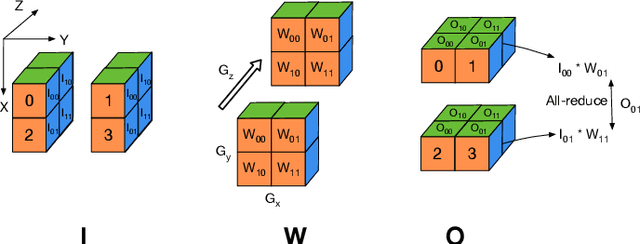
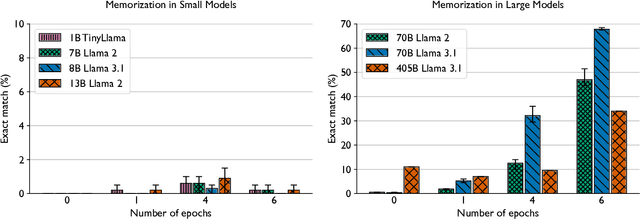
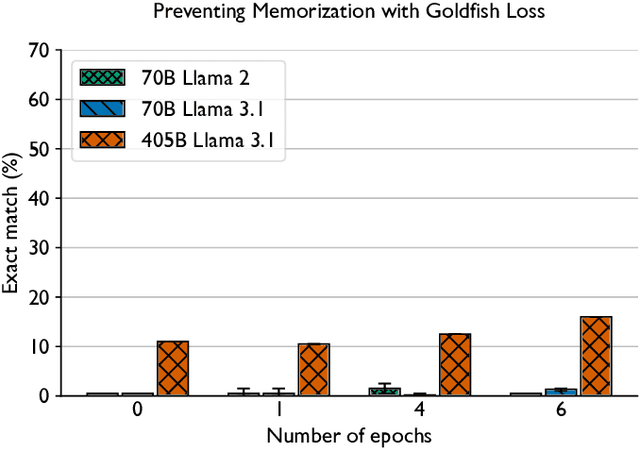
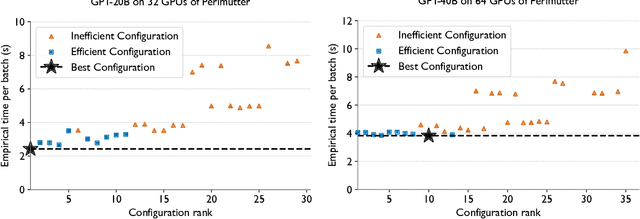
Abstract:Training and fine-tuning large language models (LLMs) with hundreds of billions to trillions of parameters requires tens of thousands of GPUs, and a highly scalable software stack. In this work, we present a novel four-dimensional hybrid parallel algorithm implemented in a highly scalable, portable, open-source framework called AxoNN. We describe several performance optimizations in AxoNN to improve matrix multiply kernel performance, overlap non-blocking collectives with computation, and performance modeling to choose performance optimal configurations. These have resulted in unprecedented scaling and peak flop/s (bf16) for training of GPT-style transformer models on Perlmutter (620.1 Petaflop/s), Frontier (1.381 Exaflop/s) and Alps (1.423 Exaflop/s). While the abilities of LLMs improve with the number of trainable parameters, so do privacy and copyright risks caused by memorization of training data, which can cause disclosure of sensitive or private information at inference time. We highlight this side effect of scale through experiments that explore "catastrophic memorization", where models are sufficiently large to memorize training data in a single pass, and present an approach to prevent it. As part of this study, we demonstrate fine-tuning of a 405-billion parameter LLM using AxoNN on Frontier.
Exploiting Sparsity for Long Context Inference: Million Token Contexts on Commodity GPUs
Feb 10, 2025



Abstract:There is growing demand for performing inference with hundreds of thousands of input tokens on trained transformer models. Inference at this extreme scale demands significant computational resources, hindering the application of transformers at long contexts on commodity (i.e not data center scale) hardware. To address the inference time costs associated with running self-attention based transformer language models on long contexts and enable their adoption on widely available hardware, we propose a tunable mechanism that reduces the cost of the forward pass by attending to only the most relevant tokens at every generation step using a top-k selection mechanism. We showcase the efficiency gains afforded by our method by performing inference on context windows up to 1M tokens using approximately 16GB of GPU RAM. Our experiments reveal that models are capable of handling the sparsity induced by the reduced number of keys and values. By attending to less than 2% of input tokens, we achieve over 95% of model performance on common long context benchmarks (LM-Eval, AlpacaEval, and RULER).
TACO: Learning Multi-modal Action Models with Synthetic Chains-of-Thought-and-Action
Dec 10, 2024



Abstract:While open-source multi-modal language models perform well on simple question answering tasks, they often fail on complex questions that require multiple capabilities, such as fine-grained recognition, visual grounding, and reasoning, and that demand multi-step solutions. We present TACO, a family of multi-modal large action models designed to improve performance on such complex, multi-step, and multi-modal tasks. During inference, TACO produces chains-of-thought-and-action (CoTA), executes intermediate steps by invoking external tools such as OCR, depth estimation and calculator, then integrates both the thoughts and action outputs to produce coherent responses. To train TACO, we create a large dataset of over 1M synthetic CoTA traces generated with GPT-4o and Python programs. We then experiment with various data filtering and mixing techniques and obtain a final subset of 293K high-quality CoTA examples. This dataset enables TACO to learn complex reasoning and action paths, surpassing existing models trained on instruction tuning data with only direct answers. Our model TACO outperforms the instruction-tuned baseline across 8 benchmarks, achieving a 3.6% improvement on average, with gains of up to 15% in MMVet tasks involving OCR, mathematical reasoning, and spatial reasoning. Training on high-quality CoTA traces sets a new standard for complex multi-modal reasoning, highlighting the need for structured, multi-step instruction tuning in advancing open-source mutli-modal models' capabilities.
ProVision: Programmatically Scaling Vision-centric Instruction Data for Multimodal Language Models
Dec 09, 2024
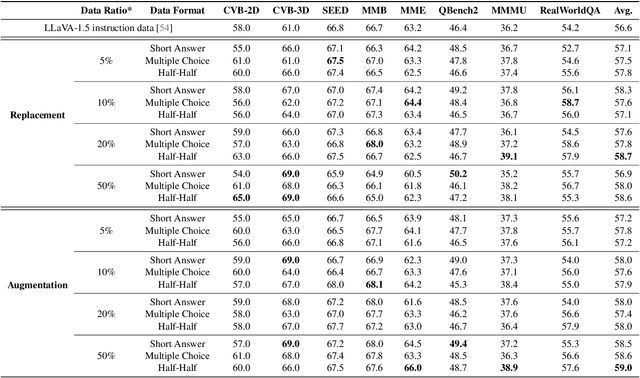
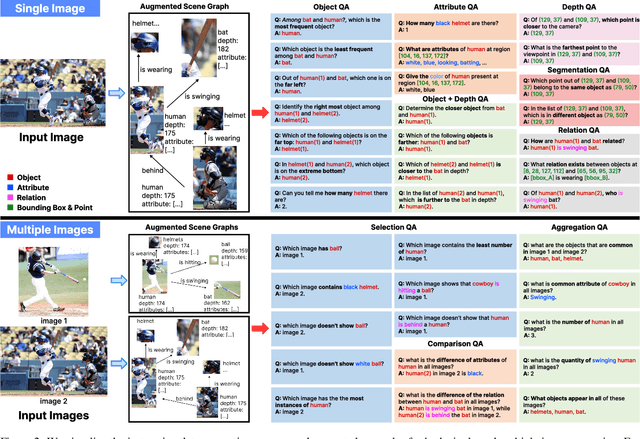
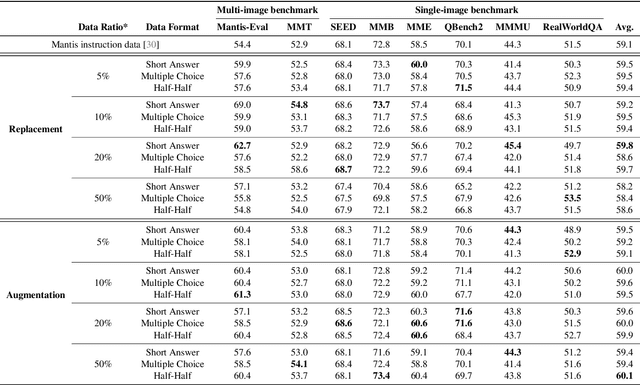
Abstract:With the rise of multimodal applications, instruction data has become critical for training multimodal language models capable of understanding complex image-based queries. Existing practices rely on powerful but costly large language models (LLMs) or multimodal language models (MLMs) to produce instruction data. These are often prone to hallucinations, licensing issues and the generation process is often hard to scale and interpret. In this work, we present a programmatic approach that employs scene graphs as symbolic representations of images and human-written programs to systematically synthesize vision-centric instruction data. Our approach ensures the interpretability and controllability of the data generation process and scales efficiently while maintaining factual accuracy. By implementing a suite of 24 single-image, 14 multi-image instruction generators, and a scene graph generation pipeline, we build a scalable, cost-effective system: ProVision which produces diverse question-answer pairs concerning objects, attributes, relations, depth, etc., for any given image. Applied to Visual Genome and DataComp datasets, we generate over 10 million instruction data points, ProVision-10M, and leverage them in both pretraining and instruction tuning stages of MLMs. When adopted in the instruction tuning stage, our single-image instruction data yields up to a 7% improvement on the 2D split and 8% on the 3D split of CVBench, along with a 3% increase in performance on QBench2, RealWorldQA, and MMMU. Our multi-image instruction data leads to an 8% improvement on Mantis-Eval. Incorporation of our data in both pre-training and fine-tuning stages of xGen-MM-4B leads to an averaged improvement of 1.6% across 11 benchmarks.
BLIP3-KALE: Knowledge Augmented Large-Scale Dense Captions
Nov 12, 2024
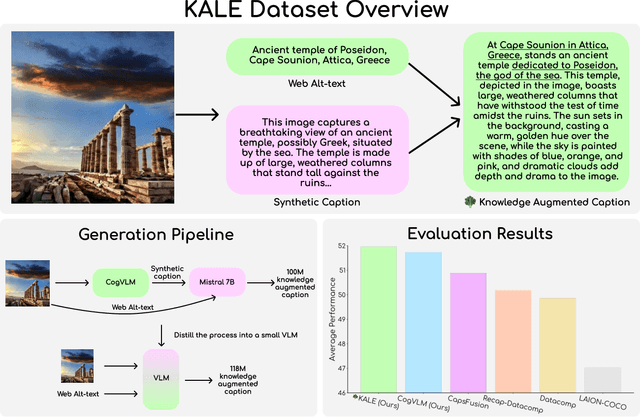
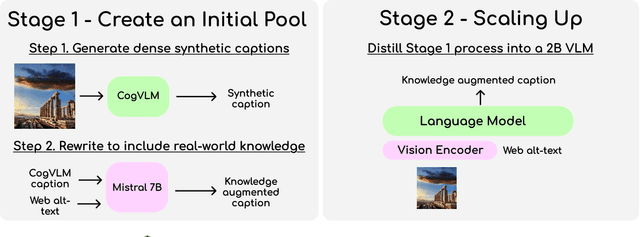

Abstract:We introduce BLIP3-KALE, a dataset of 218 million image-text pairs that bridges the gap between descriptive synthetic captions and factual web-scale alt-text. KALE augments synthetic dense image captions with web-scale alt-text to generate factually grounded image captions. Our two-stage approach leverages large vision-language models and language models to create knowledge-augmented captions, which are then used to train a specialized VLM for scaling up the dataset. We train vision-language models on KALE and demonstrate improvements on vision-language tasks. Our experiments show the utility of KALE for training more capable and knowledgeable multimodal models. We release the KALE dataset at https://huggingface.co/datasets/Salesforce/blip3-kale
xGen-MM-Vid (BLIP-3-Video): You Only Need 32 Tokens to Represent a Video Even in VLMs
Oct 21, 2024



Abstract:We present xGen-MM-Vid (BLIP-3-Video): a multimodal language model for videos, particularly designed to efficiently capture temporal information over multiple frames. BLIP-3-Video takes advantage of the 'temporal encoder' in addition to the conventional visual tokenizer, which maps a sequence of tokens over multiple frames into a compact set of visual tokens. This enables BLIP3-Video to use much fewer visual tokens than its competing models (e.g., 32 vs. 4608 tokens). We explore different types of temporal encoders, including learnable spatio-temporal pooling as well as sequential models like Token Turing Machines. We experimentally confirm that BLIP-3-Video obtains video question-answering accuracies comparable to much larger state-of-the-art models (e.g., 34B), while being much smaller (i.e., 4B) and more efficient by using fewer visual tokens. The project website is at https://www.salesforceairesearch.com/opensource/xGen-MM-Vid/index.html
xGen-VideoSyn-1: High-fidelity Text-to-Video Synthesis with Compressed Representations
Aug 22, 2024



Abstract:We present xGen-VideoSyn-1, a text-to-video (T2V) generation model capable of producing realistic scenes from textual descriptions. Building on recent advancements, such as OpenAI's Sora, we explore the latent diffusion model (LDM) architecture and introduce a video variational autoencoder (VidVAE). VidVAE compresses video data both spatially and temporally, significantly reducing the length of visual tokens and the computational demands associated with generating long-sequence videos. To further address the computational costs, we propose a divide-and-merge strategy that maintains temporal consistency across video segments. Our Diffusion Transformer (DiT) model incorporates spatial and temporal self-attention layers, enabling robust generalization across different timeframes and aspect ratios. We have devised a data processing pipeline from the very beginning and collected over 13M high-quality video-text pairs. The pipeline includes multiple steps such as clipping, text detection, motion estimation, aesthetics scoring, and dense captioning based on our in-house video-LLM model. Training the VidVAE and DiT models required approximately 40 and 642 H100 days, respectively. Our model supports over 14-second 720p video generation in an end-to-end way and demonstrates competitive performance against state-of-the-art T2V models.
xGen-MM (BLIP-3): A Family of Open Large Multimodal Models
Aug 16, 2024



Abstract:This report introduces xGen-MM (also known as BLIP-3), a framework for developing Large Multimodal Models (LMMs). The framework comprises meticulously curated datasets, a training recipe, model architectures, and a resulting suite of LMMs. xGen-MM, short for xGen-MultiModal, expands the Salesforce xGen initiative on foundation AI models. Our models undergo rigorous evaluation across a range of tasks, including both single and multi-image benchmarks. Our pre-trained base model exhibits strong in-context learning capabilities and the instruction-tuned model demonstrates competitive performance among open-source LMMs with similar model sizes. In addition, we introduce a safety-tuned model with DPO, aiming to mitigate harmful behaviors such as hallucinations and improve safety. We open-source our models, curated large-scale datasets, and our fine-tuning codebase to facilitate further advancements in LMM research. Associated resources will be available on our project page above.
MINT-1T: Scaling Open-Source Multimodal Data by 10x: A Multimodal Dataset with One Trillion Tokens
Jun 17, 2024



Abstract:Multimodal interleaved datasets featuring free-form interleaved sequences of images and text are crucial for training frontier large multimodal models (LMMs). Despite the rapid progression of open-source LMMs, there remains a pronounced scarcity of large-scale, diverse open-source multimodal interleaved datasets. In response, we introduce MINT-1T, the most extensive and diverse open-source Multimodal INTerleaved dataset to date. MINT-1T comprises one trillion text tokens and three billion images, a 10x scale-up from existing open-source datasets. Additionally, we include previously untapped sources such as PDFs and ArXiv papers. As scaling multimodal interleaved datasets requires substantial engineering effort, sharing the data curation process and releasing the dataset greatly benefits the community. Our experiments show that LMMs trained on MINT-1T rival the performance of models trained on the previous leading dataset, OBELICS. Our data and code will be released at https://github.com/mlfoundations/MINT-1T.
Coercing LLMs to do and reveal anything
Feb 21, 2024Abstract:It has recently been shown that adversarial attacks on large language models (LLMs) can "jailbreak" the model into making harmful statements. In this work, we argue that the spectrum of adversarial attacks on LLMs is much larger than merely jailbreaking. We provide a broad overview of possible attack surfaces and attack goals. Based on a series of concrete examples, we discuss, categorize and systematize attacks that coerce varied unintended behaviors, such as misdirection, model control, denial-of-service, or data extraction. We analyze these attacks in controlled experiments, and find that many of them stem from the practice of pre-training LLMs with coding capabilities, as well as the continued existence of strange "glitch" tokens in common LLM vocabularies that should be removed for security reasons.
 Add to Chrome
Add to Chrome Add to Firefox
Add to Firefox Add to Edge
Add to Edge